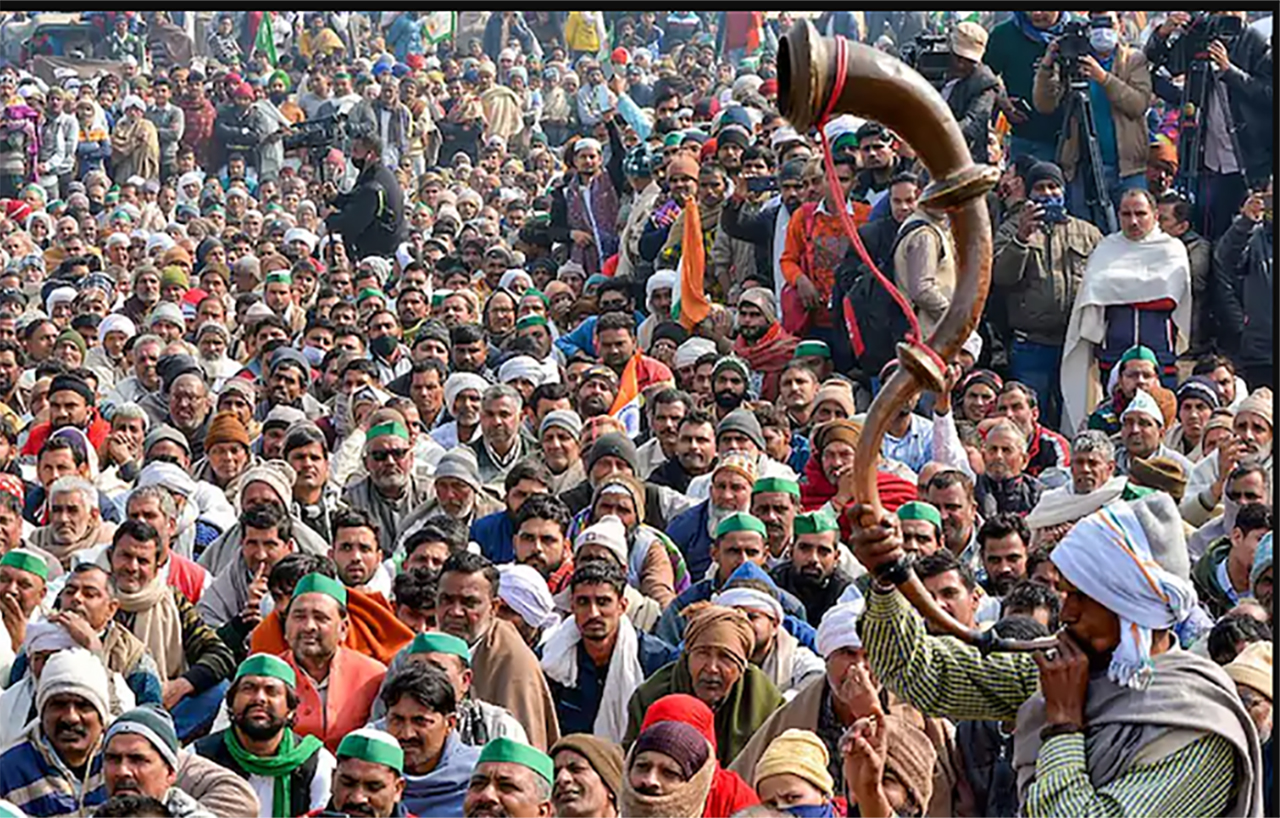Thousands of farmers gathered at Muzaffarnagar on Friday for a ‘Mahapanchayat’ in support of the Bharatiya Kisan Union (BKU)-led protest at the Ghazipur (Delhi-Uttar Pradesh) border against Centre’s new farm laws. The massive gathering of farmers from 36 Biradari at the Mahapanchayat took the oath of ‘Lota Noon’ for a social boycott – ‘Hukka Pani Bandh’ – of the Bharatiya Janata Party.
The Mahapanchayat was called a day after the farmers protest site at Ghazipur border saw heavy deployment of police forces and mobilisation of BJP cadres to clear up the protest. The Yogi government cut off electricity and supply of water at the protest site. Attempt to murder charge was registered in a FIR against Rakesh Tikait, the BKU leader spearheading the protest at the Ghazipur border site. However, things turned around dramatically after Rakesh Tikait broke down while addressing the farmers on Thursday evening. His tears and an emotional call for support brought hundreds of farmers from various districts like Meerut, Baghpat, Baraut to return to the protest site late at night. The police and the ruling party cadres retreated. The Mahapanchayat was called on the next day where thousands took the ‘Lota Noon’ pledge to carry on this struggle till the three anti-farmer farm laws are repealed by the Modi-government.
Amandeep Sandhu writes about this pledge of the farmers and traces its historical significance.
Day 66
Toll 182
#FarmersProtest
Lota Noon Oath
Completely unreported in the media, yesterday, lakhs of farmers from 36 Biradari came together at the Muzaffarnagar Mahapanchayat and took the oath of ‘Lota Noon’ for a social boycott – ‘Hukka Pani Bandh’ – of the Bharatiya Janata Party. Friends tell me this oath of salt (noon) in Ganga water in a spouted vessel (Lota) signifies that each oath taker’s individual view is now subsumed in the community’s view and those can never be separated.
The historical antecedents of this oath are yet to be established, they are not covered in textbooks. Very rarely in history have the Biradaris taken this oath. Most likely, its first occurrence was during Timur’s invasion of Delhi, 1398. Such an oath was taken in 1857, during the Meerut Uprising against the British. Today is the 70th anniversary of Mahatma Gandhi’s assassination linked to RSS/Hindu Mahasabha. Gandhi had administered the Salt Pledge before Dandhi March, not the same as the Lota Noon oath, but rooted in a similar idea.
I feel this oath, or the way farmers of Punjab and Haryana created Singhu and Tikri in the same manner of how in the 18th century Sikh Misls advanced (military term: divisions, confederacy states) to establish encampments, is significant, simply because people are ancient and our cultural history and memory in many ways define us, just like modernity defines us too. If ancient practices have to be questioned on many occasions, which they must be, we also need to see how they are invoked to create unity – in this case against the Hindutva regime. The Lota Noon pledge has led to Ghazipur site of protest swelling many times from the night of January 27, with thousands upon thousands of farmers and their supporters still arriving there.
This is a great mobilization and takes the battle to where it should always have been fought: the Hindi heartland. The need for this came because of the Red Fort flag fracas that the Hindutva forces enacted with complicity of some people within the protest and by firing the gun from the shoulder of the Kisan Mazdoor Sangharsh Committee. Hindutva was looking for an opening to create a gap between Hindus and Sikhs, isolating Punjab once again. It did not succeed. One call for ‘water from my village’ by farm leader Rajesh Tikait has led to this huge solidarity.
In fact, the heartland views the hoisting of Kisan flags, Nishan Sahib, some union flags, not as insult to the Tricolour (for the national flag was not even touched) but a claiming of our nation’s historic building, the Red Fort, from the corporates to which the government has leased it out. This is exactly why the farmers are protesting – to prevent corporate takeover of agriculture. The heartland knows there was no Khalistan flag, and this is not a Khalistan movement. Something that drove urban, middle-class India into paroxysms. Social media, take a break!
However, watching the Samyukth Kisan Morcha leadership fumble at Singhu for the last few days over this amuses me. My posts are meant to inform not comment but I want to state: What is SKMs great need to be defensive? Isn’t it time SKM reflects, bridges gaps with youth cadre, shake hands with KMSC? At this critical juncture, SKM should refrain from publicly blaming KMSC for incidents of Republic Day Tractor March. It is anyway the past, it has gifted us a vastly reinforced Ghazipur.
In fact, yesterday, there was a Sanghi attack at Singhu. The Godi media, of course, described the goons as ‘locals’ who attacked the farmers. There is clear video footage of police standing by doing nothing for a long time as the attackers started pelting stones at the farmers. Police got into action only when the farmers resisted, that too to teargas farmers. Even Molotov Cocktails were used in the attack. Thankfully, the tent towards which they were hurled did not catch fire. Some thirty to forty farmers sustained injuries. After that the police escorted the attackers as if they were state guests. No arrests were made.
It is clear that the state is down to playing dirty tricks. However, all protest sites are standing tall. Lota Noon pledge means this is going to be a long struggle ahead. Remember, after 1857 it took us 90 years to get rid of the British.
Amandeep Sandhu is a writer and novelist.
Feature Image: Farmers during Kisan Mahapanchayat against Centre’s farm laws in Muzaffarnagar. (Photo: PTI)

